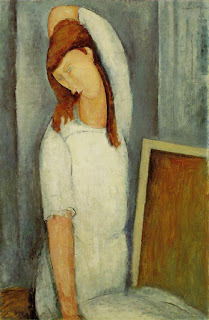My spouse and I visited the Barnes Foundation on a Saturday
afternoon in late June 2017. We purchased our tickets online a few days in
advance, but when we presented those tickets to the staff member manning the
entryway, we were surprised when she directed us to the end of a line of
approximately 20 patrons and told us that the museum was operating at capacity
and that we would not be admitted until a corresponding number of people left.
The last time we witnessed such an admission system was years ago at a bar,
when we had to wait for patrons to exit before we could enter in order to obey
fire code! We did not expect this policy from the classy Barnes Foundation!
What was more disheartening was that when we spoke to the couple preceding us
in line, they had just purchased their tickets minutes before entering the queue,
so the Barnes gives no preference to patrons who plan ahead and take the initiative
to pre-purchase admission. We were also disappointed that the museum continued
to sell tickets to our time slot, even though guests were lined up awaiting
admission. As past visitors to the museum’s original campus in Lower Merion, we
thought that the controversial move of this museum would solve admission issues.
When we purchased our tickets, we selected the 3:00 pm time slot because it
would allow us two hours inside the museum, but we lost approximately 20
minutes in the admission line. We would advise future guests not to book a time
slot later than 3:00; if we had booked the 3:30 slot (which is the last slot available),
and if we had not been admitted until 3:50 or later, we would not have had
enough time to walk through the entire collection. Note: We are only casual art
observers; if you have an extensive art background and interest, two hours is
not sufficient time to explore the collection in-depth. Enough said about the
extremely unfortunate start to our visit!
The Barnes Foundation is located on North 20th
Street, just off the Benjamin Franklin Parkway and near the Free Library, Franklin
Institute, Rodin Museum, and
Philadelphia Museum of Art. (Since 2012, the Barnes Foundation has operated in the art museum district of Philadelphia after being relocated
from a campus in Lower Merion, Pennsylvania. The original campus now houses a
public arboretum.) The museum is open Wednesdays through Mondays from
10:00 am until 5:00 pm (closed on Tuesdays). The museum offers extended Friday
evening hours on select nights (including on the first Friday of the month).
Admission is free on the first Sunday of every month. The Barnes campus offers
a small parking lot, but some street parking is also available, or you can
arrive on public transportation (including the tourist PHLASH) or via taxi or
Uber. Docent-led tours are available for an extra $20 per person (added to the
standard $25 per adult admission fee). The campus offers a museum shop,
restrooms, coat check, small lockers, a coffee bar, and the sit-down Garden Restaurant.
(You can also easily walk to nearby restaurants including Pizzeria Vetri, Buena
Onda Tacos, or Le Pain Quotidien.)
Albert Coombs Barnes established his Foundation in 1922 in order to educate
others about fine arts and horticulture. He grew up in Philadelphia in the late
1800s, where he became interested in art from his high-school classmate,
William Glackens. After obtaining his medical degree from the University of
Pennsylvania, Barnes studied physiological chemistry and pharmaceutics in Germany. In the early 1900s,
Barnes returned to the United States, married, and invented a medical compound
called Argyrol, a silver antiseptic used to prevent infant blindness. This
lucrative discovery provided Barnes with the financial means to amass his art
collection.
The museum owns over 3,000 Impressionist, post-Impressionist and early-modern paintings. Its collected
works are considered to be one of the greatest private collections in existence. The Foundation owns
record numbers of certain painters, including Renoir (181 works), Glackens
(79), Cezanne (69), Matisse (59), Picasso (46), Prendergast (26), Rousseau
(18), Modigliani (16), Degas (11), Van Gogh (7), Seurat (6), El Greco (4),
Manet (4), Monet (4), Rubens (3), Gaugin (2), Titian (1), and Goya (1). The
museum also displays pieces of furniture, sculptures, ceramics, metalwork,
textiles, and jewelry. The museum displays its collection in a unique way
called “wall ensembles”, which arranges artwork from different time periods and
places to allow the viewer to draw comparisons. Also, the artwork at the Barnes
is not hung in one evenly spaced row progressing across a wall, but instead in
many rows and columns on a single wall.
Excluding our initial admittance issue, we enjoyed our visit
to the Barnes Foundation; it offers an overwhelmingly impressive art
collection.



















No comments:
Post a Comment